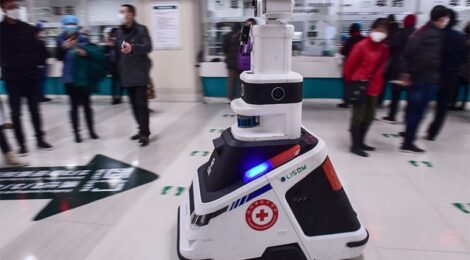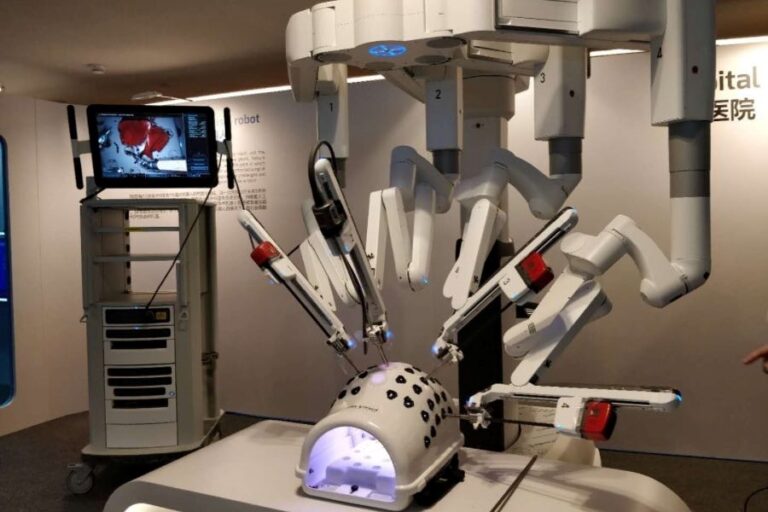
China Robotics Rise 5 – Medical robots Part 2

We continue our short research on Medical robots in China for our column “Galileo Observer”. In this second part, we underline medical robots applications and the future developments of the sector in a very dynamic and promising part of “China robotics rise”.
APPLICATION OF MEDICAL ROBOTS
- The application of medical robots is in the introduction stage, and automation is in the auxiliary stage.
The development of medical robots can be traced back to the neurosurgical biopsy operation completed in 1985 using industrial robot-assisted positioning. It was the first time that robotic technology was combined with medicine, and it has since opened a new era of medical robots.
Since then, some countries have taken the lead in developing surgical robot-related technologies and promoting the development of medical robots. In September 2010, the University Medical Center in Ljubljana performed a truly robotic surgery on the femoral vasculature. It did not replicate the movements of the human hand, but operated on its own after pressing a button.
Since 2014, China has begun to introduce surgical robots. At present, they are mainly introduced in tertiary hospitals in some central cities. The Second Affiliated Hospital of Kunming Medical University, the Children’s Hospital of Zhejiang University School of Medicine and other hospitals have introduced da Vinci medical robots.
Overall, the current application of medical robots in China’s medical field is still in the introduction stage, and both the technology of the robot itself and the operational capabilities of medical staff require a process of cultivation. Judging from the degree of automation of medical robots, at this stage, medical robots are not yet able to perform full-process, fully automated surgeries, and a doctor’s intervention is still required during the surgery.
- The demand for medical robots in China is increasing and the market penetration rate is low.
As the aging of the population intensifies, the application demand for medical robots is gradually increasing, and a variety of medical robots with different functions have been used. From the perspective of market size, the current installed distribution of medical robots in China is mainly concentrated in tertiary comprehensive hospitals and some public hospitals. The market penetration rate is at a low level, and the market size only accounts for about 5% of the global medical robot market size. Data shows that China’s medical service robot market size reached 5.94 billion yuan in 2020, and it is expected that China’s medical robots will further reach 9.71 billion yuan in 2022.
- Rehabilitation robots account for the first place, followed by auxiliary robots
According to the classification of the International Federation of Robotics (IFR), medical robots can be divided into four categories: surgical robots, rehabilitation robots, auxiliary robots and medical service robots. From the perspective of market structure, rehabilitation robots account for the highest proportion of 47%; surgical robots account for 17%; auxiliary robots account for 23%; and medical service robots account for 13%.
Among the businesses covered by Chinese medical robot companies, the number of main rehabilitation robots and auxiliary robots accounts for a relatively high proportion. More than 10 domestic rehabilitation robot companies have completed one or more rounds of financing. There are about 20-30 domestic companies in the entire track. The competition is fierce and the homogeneity of products is serious. Companies will differ from each other based on clinical progress and technology. Conduct all-round competition in terms of advantages, marketing capabilities, sales capabilities, product prices, etc. The main brands and application characteristics of various types of medical robots are as follows:
- Investment enthusiasm has declined, with industry investment and financing exceeding 300 million yuan in 2019
Judging from the investment and financing situation in the industry, from 2015 to 2019, the investment enthusiasm in the field of medical robots in my country showed a trend of first increasing and then decreasing. In 2017, the investment and financing enthusiasm was relatively high, with the number of investments and the amount of investment reaching 6 and 981 million yuan respectively. From 2018 to 2019, affected by the cold winter of capital, investment in medical robots declined. The number of investment cases dropped to 5 in 2019, with an investment amount of 333 million yuan.

FUTURE DEVELOPMENTS
- The aging of the population prompts the accelerated development of medical robots
In recent years, China’s aging population has entered rapid development ahead of schedule. According to data from the National Bureau of Statistics, it is expected that the size of China’s elderly population will reach 500 million by 2050. Faced with such a huge number of elderly people, elderly care has become a social problem that our country faces and needs to be solved urgently. At present, medical robots have become the preferred elderly care equipment in the smart elderly care model. In the era of artificial intelligence, rehabilitation robots, surgical robots, exoskeleton robots, etc. will be more commonly used.
- Policy promotion, medical robots usher in a period of development opportunities
The rapid growth of the domestic medical robot market is inseparable from policy support. Since 2015, the country has issued a series of important policy documents to promote the transformation and upgrading of China’s manufacturing. As an important area of people’s livelihood, the medical field has always been the focus of major policy documents to support the research and development and production of medical robots.
- The product’s human-computer interaction and perception and cognition capabilities are more accurate
With the in-depth integration of medical robots with cutting-edge technologies such as artificial intelligence, brain-computer interaction, 5G networks, AR/VR, and big data, the level of interaction with doctors and patients will be further improved, and the level of interaction with doctors and patients will be further improved, and data, objects, and the environment will be better understood. Accurate perception promotes the intelligent development of medical robots and realizes the integration of intelligent medical care.
- The rise of new robots such as single-hole surgery, nano-targeting, and flexible robots
Compared with multi-hole endoscopic robots, single-hole endoscopic surgical robots have the characteristics of smaller wounds and lower costs. In the future, they may become a new surgical robot product that breaks the monopoly of the da Vinci multi-hole surgical robot market. North America, the European Union, Japan and South Korea have successively initiated research projects on single-port surgical robots. Shanghai Jiao Tong University leads the world in the development of single-port surgical robots, and is expected to become an emerging segment in my country’s medical robot industry to achieve cornering overtaking.
Traditional robots help humans work, while micro and nanotechnology can expand human capabilities. If robotics technology can be combined with medical research and development technology, micro-nano robots can drive the rapid development of the robotics industry in the next 50 years. At present, there are a large number of emerging medical robot companies in China, but most of them are foundries and their innovation capabilities are relatively lacking. However, if nanorobots can be truly used in clinical fields and achieve large-scale applications in the future, the market size of medical robots may exceed that of automotive robots.
Overall, in China medical robots are currently in their preliminary stages and are still relatively small. However, judging from the application effects, the large-scale use of robots will be a trend in the medical field in the future, if domestic medical robots want to catch up, they must find another way, change lanes to overtake, and face the challenge of building an innovative ecosystem for medical robots.
Written by Marco Bonaglia



